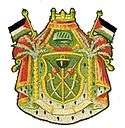Hashemites
| House of Hashim / Hashmi's | |
|---|---|
 .png)  Coats of arms of Jordan, Iraq, and Hejaz | |
| Country | Hejaz (in present-day Saudi Arabia), Syria, Iraq, Jordan |
| Parent house | Dhawu Awn, a branch of Banu Qatadah, of Banu Hasan, of Banu Hashim, of Quraysh |
| Titles |
|
| Founded |
1916 in Hejaz 1920 in Syria 1921 in Iraq and Jordan |
| Founder | Hussein ibn Ali |
| Final ruler |
Ali in Hejaz Faisal I in Syria Faisal II in Iraq |
| Current head |
Jordan: Abdullah II Iraq: Ra'ad bin Zeid |
| Deposition |
1925 in Hejaz (Saudi conquest) 1920 in Syria (Franco-Syrian War) 1958 in Iraq (14 July Revolution) |

The House of Hashim, better known as the Hashemites Hashmi (Arabic: الهاشميون, al-Hāshimīyūn; also "Hashimites" or "Hashimids"), are the royal family of the Hejaz (1916–1925), Iraq (1921–1958), and Jordan (1921–present). The family belongs to the Dhawu Awn, one of the branches of the Hasanid Sharifs of Mecca – also referred to as Hashemites – who ruled Mecca continuously from the 10th century until its conquest by the House of Saud in 1924. Their eponymous ancestor is Hashim ibn Abd Manaf, great-grandfather of the Islamic prophet, Muhammad.
The current dynasty was founded by Sharif Hussein ibn Ali, who was appointed as Sharif and Emir of Mecca by Sultan Abdul Hamid II in 1908, then in 1916 was proclaimed King of the Arab Lands (but only recognized as King of the Hejaz) after initiating the Arab Revolt against the Ottoman Empire. His sons Abdullah and Faisal assumed the thrones of Jordan and Iraq in 1921. The dynasty is the oldest ruling dynasty in the Islamic World, and the second-oldest in the world.[1]
History
The Hashemites[2] claim to trace their ancestry from Hashim ibn 'Abd Manaf (died c. 497 AD), the great-grandfather of the Islamic prophet Muhammad, although the definition today mainly refers to the descendants of Muhammad's daughter Fatimah.[3] The early history of the Hashemites saw them in a continuous struggle against the Umayyads for control over who would be the caliph or successor to Muhammad. The Umayyads were of the same tribe as the Hashemites, but a different clan. After the overthrow of the Umayyads, the Abbasids would present themselves as representatives of the Hashemites, as they claimed descent from Abbas ibn ‘Abd al-Muttalib, an uncle of Muhammad. Muhammad's father had died before he was born, and his mother died while he was a child, so Muhammad was raised by his uncle Abu Talib ibn ‘Abd al-Muttalib, chief of the Hashemites.[4]
From the 10th century onwards, the sharif (religious leader) of Mecca and its Emir was, by traditional agreement, a Hashemite. Before World War I, Hussein bin Ali of the Hashemite Dhawu-'Awn clan ruled the Hejaz on behalf of the Ottoman sultan. For some time it had been the practice of the Sublime Porte to appoint the Emir of Mecca from among a select group of candidates. In 1908, Hussein bin Ali was appointed to the Emirate of Mecca. He found himself increasingly at odds with the Young Turks in control at Istanbul, while he strove to secure his family's position as hereditary Emirs.
During and after World War I
Sharif Hussein bin Ali rebelled against the rule of the Ottomans during the Arab Revolt of 1916.[5] Between 1917 and 1924, after the collapse of Ottoman power, Hussein bin Ali ruled an independent Hejaz, of which he proclaimed himself king, with the tacit support of the British Foreign Office. His supporters are sometimes referred to as "Sharifians" or the "Sharifian party". Hussein bin Ali's chief rival in the Arabian Peninsula, the king of the Najd (highlands), Ibn Saud, annexed the Hejaz in 1925 and established his own son, Faysal bin Abdulaziz Al Saud, as governor. The region was later incorporated into Saudi Arabia.
Hussein bin Ali had five sons:
- Ali, who briefly succeeded to the throne of Hejaz before its loss to the Saud family in 1925.
- Abdullah, became the amir of Transjordan in 1921 and king of Jordan in 1946, and whose descendants continue to rule the kingdom known ever since as the Hashemite Kingdom of Jordan.
- Faisal, briefly proclaimed King of the Arab Kingdom of Syria in 1920, became King of Iraq in 1921.
- Prince Zeid bin Hussein, who moved to Jordan when his brother's grandson, King Faisal II of Iraq, was overthrown and murdered in a coup in 1958.
- Hassan, died at a young age.
Family tree
See also
| Wikimedia Commons has media related to Hashemites. |
References
- ↑ http://themuslim500.com/profile/king-abdullah-ii-jordan
- 1 2 The Hashemites: Jordan's Royal Family
- ↑ T. E. Lawrence (1926), Seven Pillars of Wisdom, reprinted 2000 Penguin classics, p. 48
- ↑ Time-Life Books, What Life Was Like: In the Land of the Prophet, p. 17
- ↑ T. E. Lawrence (1926), Seven Pillars of Wisdom, reprinted 2000 Penguin classics, p. 53
- ↑ Stitt, George (1948). A Prince of Arabia, the Amir Shereef Ali Haider. George Allen & Unwin, London.
- ↑ Bosworth, Clifford Edmund (1996). The New Islamic Dynasties. Edinburgh University Press.
- ↑ Antonius, George (1946). The Arab Awakening. Capricorn Books, New York.
- ↑ The Hashemites, 1827-present